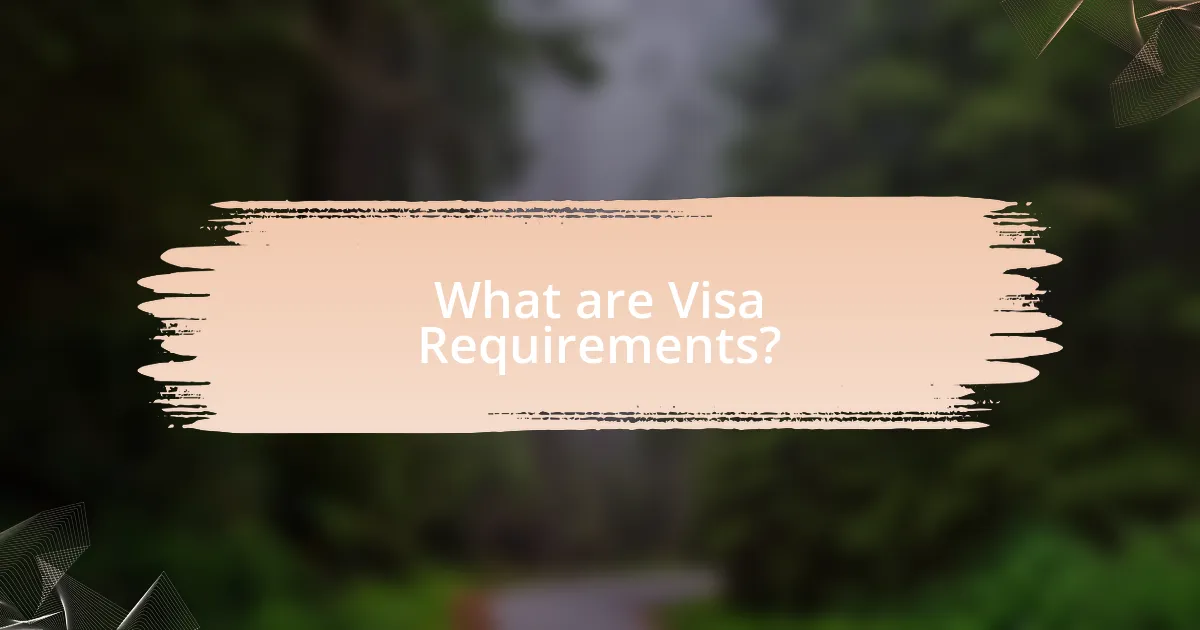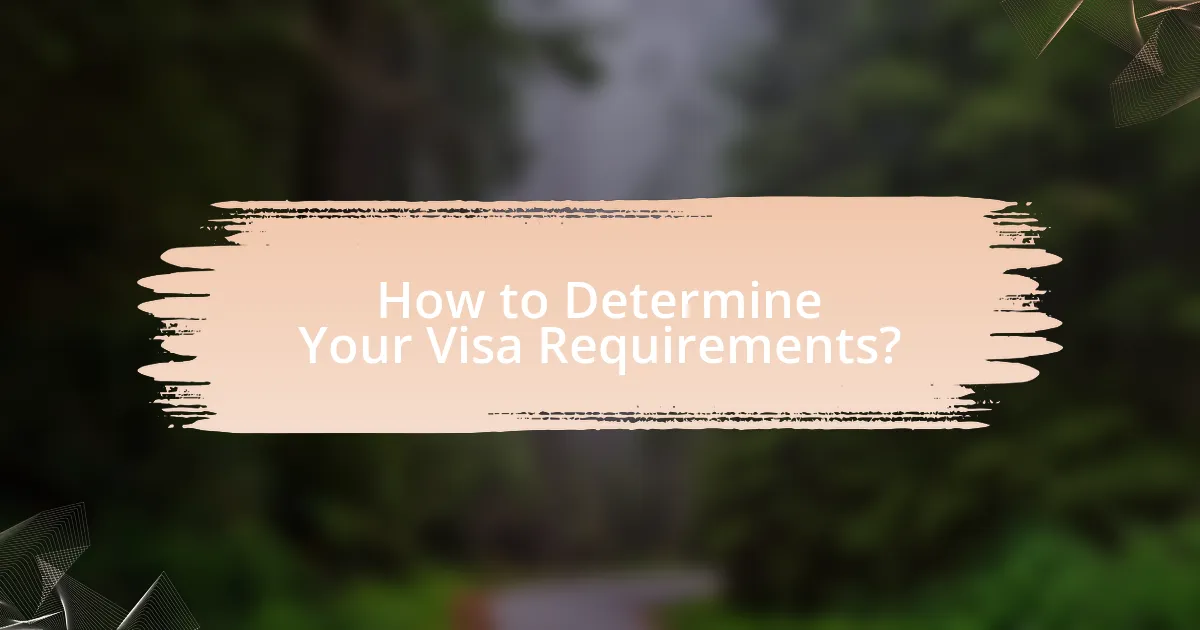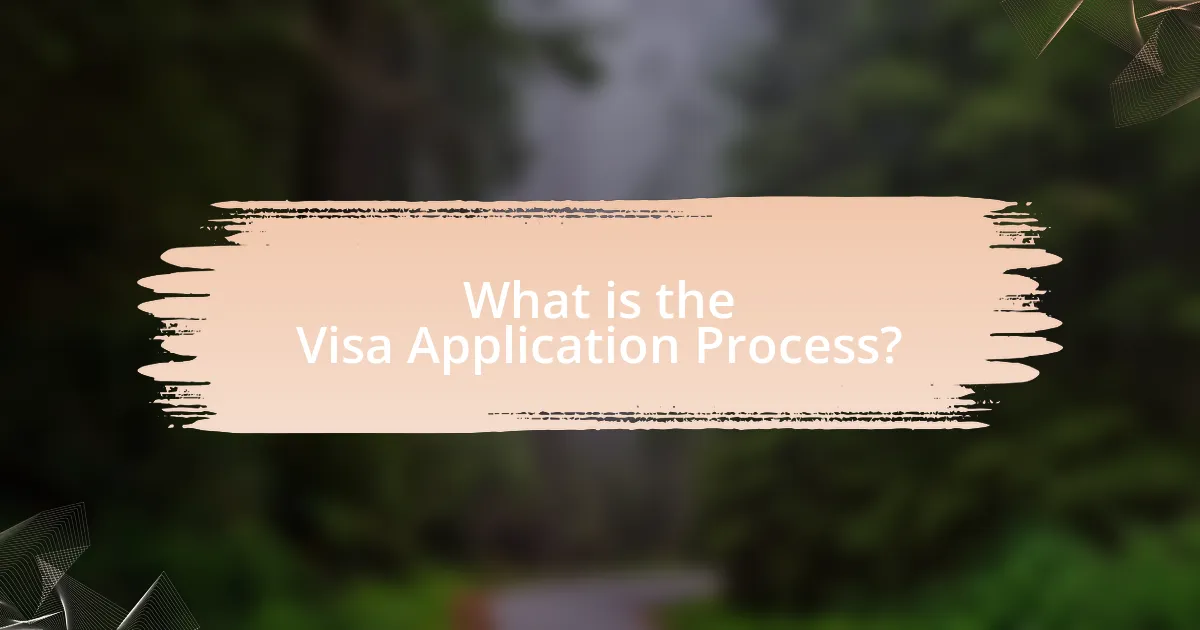Visa requirements are the specific conditions and documentation necessary for individuals to enter, stay, or transit through a country. This article provides a comprehensive guide on navigating these requirements, detailing how they vary by country and the factors influencing them, such as diplomatic relations and security concerns. It outlines the importance of understanding visa requirements for travelers, the potential risks of non-compliance, and the steps to determine and fulfill these requirements. Additionally, the article covers the visa application process, common challenges faced, and best practices for ensuring a smooth application experience.

What are Visa Requirements?
Visa requirements are the specific conditions and documentation that individuals must fulfill to enter, stay, or transit through a country. These requirements typically include a valid passport, a completed visa application form, a recent passport-sized photograph, proof of accommodation, financial means to support the stay, and sometimes a travel itinerary or invitation letter. For example, the United States requires a visa application fee, a valid passport, and an interview at a U.S. embassy or consulate for most visa types.
How do Visa Requirements vary by country?
Visa requirements vary significantly by country, influenced by factors such as diplomatic relations, security concerns, and immigration policies. For instance, citizens of the United States can travel to over 180 countries without a visa or can obtain a visa on arrival, while citizens of countries with less favorable diplomatic standing may face stricter visa requirements, including lengthy application processes and additional documentation. The Schengen Area allows for visa-free travel among its member states for short stays, while countries like India and China have specific visa categories based on the purpose of travel, such as tourism, business, or study. These variations are documented in resources like the Henley Passport Index, which ranks passports based on the number of destinations their holders can access without a prior visa.
What factors influence Visa Requirements for different nations?
Visa requirements for different nations are influenced by diplomatic relations, security concerns, economic factors, and immigration policies. Diplomatic relations determine the level of trust and cooperation between countries, often leading to visa exemptions or simplified processes for citizens of allied nations. Security concerns arise from the need to prevent illegal immigration and terrorism, prompting countries to impose stricter visa requirements on nations perceived as high-risk. Economic factors, such as trade agreements and tourism interests, can also affect visa policies, as countries may seek to encourage travel and business exchanges. Lastly, each nation’s immigration policies reflect its priorities regarding population control, labor market needs, and cultural integration, further shaping visa requirements.
How do diplomatic relations affect Visa Requirements?
Diplomatic relations significantly influence visa requirements by determining the level of trust and cooperation between countries. When two nations maintain strong diplomatic ties, they often establish agreements that facilitate easier travel, such as visa waivers or simplified application processes. For instance, the Schengen Agreement allows citizens of member countries to travel freely without visas, reflecting the high level of diplomatic cooperation among those nations. Conversely, strained diplomatic relations can lead to stricter visa requirements, as seen in cases where countries impose travel bans or require extensive documentation for entry. This correlation between diplomatic relations and visa policies is evident in historical contexts, such as the visa restrictions imposed during periods of geopolitical tension.
Why are Visa Requirements important for travelers?
Visa requirements are important for travelers because they dictate the legal permissions needed to enter a foreign country. These requirements ensure that travelers meet specific criteria, such as valid identification, financial stability, and sometimes health regulations, which help maintain national security and public order. For instance, countries like the United States and Canada have stringent visa processes to screen applicants, thereby reducing the risk of illegal immigration and enhancing safety. Additionally, understanding visa requirements helps travelers avoid legal issues, such as being denied entry or facing deportation, which can arise from non-compliance with immigration laws.
What risks do travelers face without understanding Visa Requirements?
Travelers face significant risks without understanding visa requirements, including denial of entry, legal penalties, and deportation. Without proper knowledge of visa regulations, travelers may arrive at their destination only to be turned away at the border due to missing or incorrect documentation. Legal penalties can include fines or bans on future travel to that country, as many nations enforce strict immigration laws. Additionally, travelers may incur financial losses from non-refundable travel expenses if they are unable to enter their destination. Understanding visa requirements is crucial to avoid these serious consequences.
How can Visa Requirements impact travel plans?
Visa requirements can significantly impact travel plans by determining whether a traveler can enter a country, the duration of their stay, and the activities they can engage in. For instance, travelers may need to apply for a visa well in advance, which can lead to delays in travel arrangements. Additionally, specific visa types may restrict entry based on the purpose of travel, such as tourism, business, or study, thereby influencing the itinerary and accommodations. According to the International Air Transport Association, approximately 30% of travelers experience issues related to visa requirements, which can result in canceled trips or unexpected expenses.

How to Determine Your Visa Requirements?
To determine your visa requirements, first identify your nationality and the country you plan to visit. Each country has specific visa policies based on the traveler’s nationality, which can be verified through official government websites or consulates. For example, the U.S. Department of State provides a comprehensive list of visa requirements for U.S. citizens traveling abroad. Additionally, resources like the International Air Transport Association (IATA) offer tools to check visa requirements based on nationality and destination. This ensures accurate and up-to-date information, as visa regulations can change frequently.
What steps should you take to find out your Visa Requirements?
To find out your visa requirements, start by visiting the official government website of the country you plan to visit. This site typically provides the most accurate and up-to-date information regarding visa types, application processes, and necessary documentation. Additionally, you can consult the embassy or consulate of that country for personalized assistance and clarification on specific requirements. According to the U.S. Department of State, each country has unique visa policies that can change frequently, making official sources essential for reliable information.
How can online resources assist in determining Visa Requirements?
Online resources assist in determining visa requirements by providing up-to-date information on specific country regulations and application processes. Websites such as government immigration portals, travel advisory sites, and visa service providers offer detailed guidelines, including necessary documentation, eligibility criteria, and processing times. For instance, the U.S. Department of State’s website outlines visa categories and requirements for various nationalities, ensuring travelers access accurate and current information. Additionally, online forums and user-generated content can provide personal experiences and tips, further aiding individuals in understanding the complexities of visa applications.
What role do embassies and consulates play in providing Visa information?
Embassies and consulates serve as primary sources of visa information for travelers seeking entry into a foreign country. They provide detailed guidance on visa application processes, requirements, and documentation needed for various types of visas. For instance, embassies often publish official guidelines on their websites, outlining specific criteria such as financial proof, invitation letters, and health insurance, which are essential for visa approval. Additionally, consular staff are available to answer inquiries and assist applicants in understanding the nuances of visa regulations, ensuring that travelers have accurate and up-to-date information. This role is crucial, as it helps prevent application errors that could lead to delays or denials, thereby facilitating smoother international travel.
What documents are typically needed for Visa applications?
Visa applications typically require a valid passport, a completed application form, and a recent passport-sized photograph. Additionally, applicants often need to provide proof of financial means, travel itinerary, and any necessary supporting documents specific to the visa type, such as an invitation letter or employment verification. These requirements are established by immigration authorities to ensure that applicants meet the necessary criteria for entry into the country.
How do specific documents vary based on Visa type?
Specific documents vary based on Visa type, as each Visa category has distinct requirements tailored to its purpose. For instance, a tourist Visa typically requires a passport, a completed application form, and proof of accommodation, while a student Visa necessitates an acceptance letter from an educational institution, proof of financial means, and sometimes a health insurance certificate. Employment Visas often demand a job offer letter, labor certification, and specific qualifications or credentials related to the job. These variations are established by immigration authorities to ensure that applicants meet the criteria relevant to their intended activities in the host country.
What common mistakes should be avoided when preparing documents?
Common mistakes to avoid when preparing documents for visa applications include failing to read the instructions carefully, submitting incomplete forms, and not providing required supporting documents. Reading the instructions ensures that applicants understand specific requirements, as each visa type may have unique criteria. Incomplete forms can lead to delays or rejections, as authorities require all sections to be filled out accurately. Additionally, omitting necessary supporting documents, such as proof of financial stability or travel itineraries, can result in an application being deemed insufficient. According to the U.S. Department of State, nearly 30% of visa applications are denied due to errors or missing information, highlighting the importance of thorough preparation.

What is the Visa Application Process?
The visa application process involves several key steps that applicants must follow to obtain a visa for travel. First, individuals must determine the type of visa required based on their purpose of travel, such as tourism, work, or study. Next, applicants complete the appropriate visa application form, which can often be found on the official website of the embassy or consulate of the destination country.
After submitting the application form, applicants typically need to pay a visa fee, which varies by country and visa type. Following payment, individuals may be required to schedule an interview at the embassy or consulate, where they present supporting documents such as a passport, photographs, and proof of financial means.
Finally, the embassy or consulate processes the application, which can take anywhere from a few days to several weeks, depending on the country and type of visa. Once approved, the visa is stamped in the applicant’s passport, allowing them to travel to the destination country.
How do you complete a Visa application?
To complete a Visa application, you must gather required documents, fill out the application form accurately, and submit it along with the applicable fees. The required documents typically include a valid passport, photographs, proof of travel itinerary, and financial statements. Accuracy in filling out the application form is crucial, as errors can lead to delays or rejections. Submitting the application usually involves either online submission or in-person delivery at the relevant embassy or consulate, depending on the Visa type and country.
What information is usually required in a Visa application form?
A Visa application form typically requires personal information such as the applicant’s full name, date of birth, nationality, and passport details. Additionally, it often asks for contact information, travel itinerary, purpose of travel, and financial information to demonstrate the ability to support oneself during the stay. Supporting documents like photographs, proof of accommodation, and travel insurance may also be required. These requirements are standard across many countries to ensure proper identification and assessment of the applicant’s eligibility for a visa.
How can you ensure your application is complete and accurate?
To ensure your application is complete and accurate, meticulously review each section of the application against the requirements outlined by the visa authority. This includes verifying that all necessary documents are included, such as identification, financial statements, and any supporting materials specific to your visa type. Additionally, cross-check the information provided for consistency and correctness, ensuring that names, dates, and other critical details match across all documents. According to the U.S. Citizenship and Immigration Services, incomplete applications can lead to delays or denials, emphasizing the importance of thoroughness in the application process.
What are the common challenges faced during the Visa application process?
Common challenges faced during the Visa application process include incomplete documentation, lengthy processing times, and complex eligibility criteria. Incomplete documentation often leads to delays or rejections, as applicants may overlook required forms or supporting materials. Lengthy processing times can vary significantly by country and visa type, causing uncertainty and potential travel disruptions. Additionally, complex eligibility criteria can confuse applicants, particularly regarding financial requirements, sponsorship, or specific qualifications, which may result in misunderstandings or errors in the application. These challenges are well-documented in various immigration studies, highlighting the need for thorough preparation and understanding of the specific requirements for each visa type.
How can you address delays or rejections in your Visa application?
To address delays or rejections in your Visa application, first, contact the relevant embassy or consulate to inquire about the status of your application. This direct communication can provide clarity on the reasons for the delay or rejection. If the application is delayed, ensure that all required documents are submitted and check for any additional information requested by the authorities. In cases of rejection, review the rejection notice carefully to understand the specific reasons and gather any necessary documentation to address those issues. According to the U.S. Department of State, applicants can appeal certain visa denials or reapply with corrected information, which can improve the chances of approval.
What resources are available for assistance with Visa applications?
Government websites, such as the U.S. Citizenship and Immigration Services (USCIS) and the UK Visas and Immigration, provide official resources for assistance with visa applications. These websites offer comprehensive information on application procedures, required documents, and eligibility criteria. Additionally, non-profit organizations and immigration law firms often provide guidance and support services, including legal advice and application assistance, to help applicants navigate the complexities of visa processes.
What are the best practices for navigating Visa Requirements?
The best practices for navigating visa requirements include thorough research, timely application, and accurate documentation. Individuals should start by identifying the specific visa type needed for their travel purpose, as requirements vary significantly by country and visa category. It is essential to consult official government websites or trusted sources to obtain the most current and accurate information regarding visa requirements.
Timely application is crucial; many countries recommend applying at least several weeks in advance of travel to account for processing times. Additionally, applicants must ensure that all required documents, such as passports, photographs, and financial statements, are complete and meet the specified criteria.
Following these practices minimizes the risk of delays or rejections, as evidenced by the fact that incomplete applications are a common reason for visa denials.
How can you stay updated on changing Visa policies?
To stay updated on changing Visa policies, regularly check official government websites and subscribe to their newsletters. Government websites, such as the U.S. Department of State or the immigration authority of your country, provide the most accurate and timely information regarding Visa regulations. Additionally, following reputable news outlets and immigration-focused organizations on social media can offer real-time updates and insights into policy changes.
What tips can help streamline the Visa application process?
To streamline the Visa application process, applicants should thoroughly research the specific requirements for their desired Visa type. Understanding the necessary documentation, fees, and timelines can significantly reduce delays. For instance, the U.S. Department of State provides detailed guidelines on the required forms and supporting documents for various Visa categories, which helps applicants prepare accurately and avoid common pitfalls. Additionally, submitting a complete application package and ensuring all information is accurate can prevent processing setbacks, as incomplete applications are often returned for corrections.